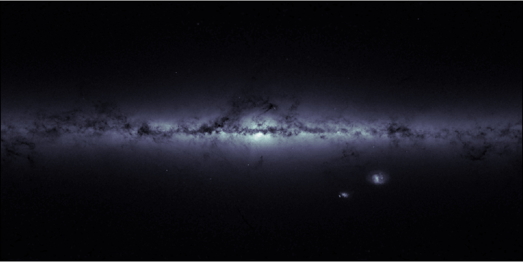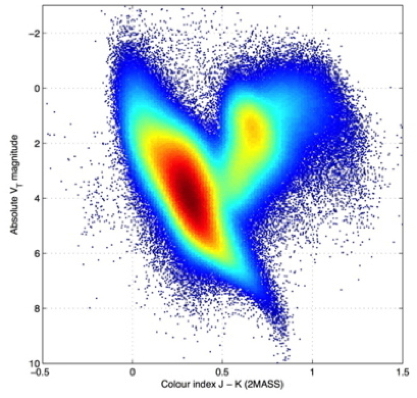After the launch, on decembre 19, 2013and a 6-month long period of commissioning in orbit,the satellite started routine scientific operations on 25 July 2014. Located at the Lagrange point L2, 1.5 million km from Earth, Gaia surveys stars and many other astronomical objects as it spins, observing circular swathes of the sky. By repeatedly measuring the positions of the stars with extraordinary accuracy, Gaia can tease out their distances and motions through the Milky Way galaxy.
These observations have allowed the measure of numerous variable stars. See for instance the observations of Cepheids and RR Lyrae in the Large Magellanic Cloud.

In one year, each star has been observed about 14 times. This is generally not enough to disentangle the parallax and proper motions.
To overcome this, the scientists have combined Gaia data with positions extracted from the Tycho-2 catalogue, based on data taken between 1989 and 1993 by Gaia’s predecessor, the Hipparcos satellite.

Figure 2 is the result of luminosities determined from the data from the first year of Gaia observations combined with data from the Tycho 2 Catalog, and colors obtained from ground observations in the near infrared (2MASS survey ) for about a quarter of the stars of Tycho-2 catalog. The accumulation of data with Gaia will yield a diagram with many more stars (about one billion against 500 000 here), observed over a much longer duration (5 or 6 years against 10 months here), throughout HR diagram (whereas here, the selection is that of the stars observed with Tycho, therefore essentially the stars of the main sequence and giant branch), and sequences much better defined with the expected accuracy of Gaia for both trigonometric parallax (so luminosities) than for color (hence temperature), and interstellar extinction.
As Gaia has been conducting its repeated scans of the sky to measure the motions of stars, it has also been able to detect whether any of them have changed their brightness, and in doing so, has started to discover some very interesting astronomical objects.
Gaia has detected hundreds of transient sources so far, with its first supernova discovered on August 30, 2014.
These detections are routinely shared with the community at large as soon as they are spotted in the form of ‘Science Alerts’, enabling rapid follow-up observations to be made using ground-based telescopes in order to determine their nature.
Recently, Gaia also measured the movement of a spectroscopic binary.
When the two components of a binary star are bright enough and have comparable brightness, the spectra of the RVS may show absorption lines which are doubled for a majority transits CCDs : when the radial velocities of the two components are distinct. Each transit CCD lasts four seconds and therefore allows a detailed analysis of rapid changes in radial velocity.

Figure 3 shows the example of HIP 70674, an SB2 spectroscopic binary with visual magnitude V=7.99, composed of two stars of almost the same luminosity. The stars are orbiting each other in a circular orbit in four days (Griffin & Suchkov 2003). HIP 70674 was observed by the RVS in August 2014, December 2014, and March 2015. The top plot shows the spectrum of HIP 70674 in two different transits, corresponding to two different phases of the orbit. The spectrum was obtained when the difference between the two radial velocities is maximum. The absorption lines in this spectrum show very clearly a double-peaked profile. The bottom spectrum was obtained when the radial velocity difference was much smaller. In this case, the absorption lines of the two components are nearly superposed. The bottom plot shows the radial velocities of the two components measured from the RVS spectra in the six transits, compared with the predicted radial velocity curves, as a function of the orbital phase.
Gaia observes also numerous asteroïds : 50 000 in 8 months have been identified from 418 000 observations associated to asteroïds.
See also the various articles gathered under the pages :
• First year
• The observations
